International Trade Finance and Investment
VerifiedAdded on 2023/01/04
|11
|3949
|9
AI Summary
This report explores the concepts of international trade, finance, and investment. It discusses the background of financial markets, capital allocation within domestic and international markets, and evaluates the economy of Australia. The report also highlights the challenges faced by countries due to industrialization and trade policies. Get expert study material on international trade and finance at Desklib.
Contribute Materials
Your contribution can guide someone’s learning journey. Share your
documents today.
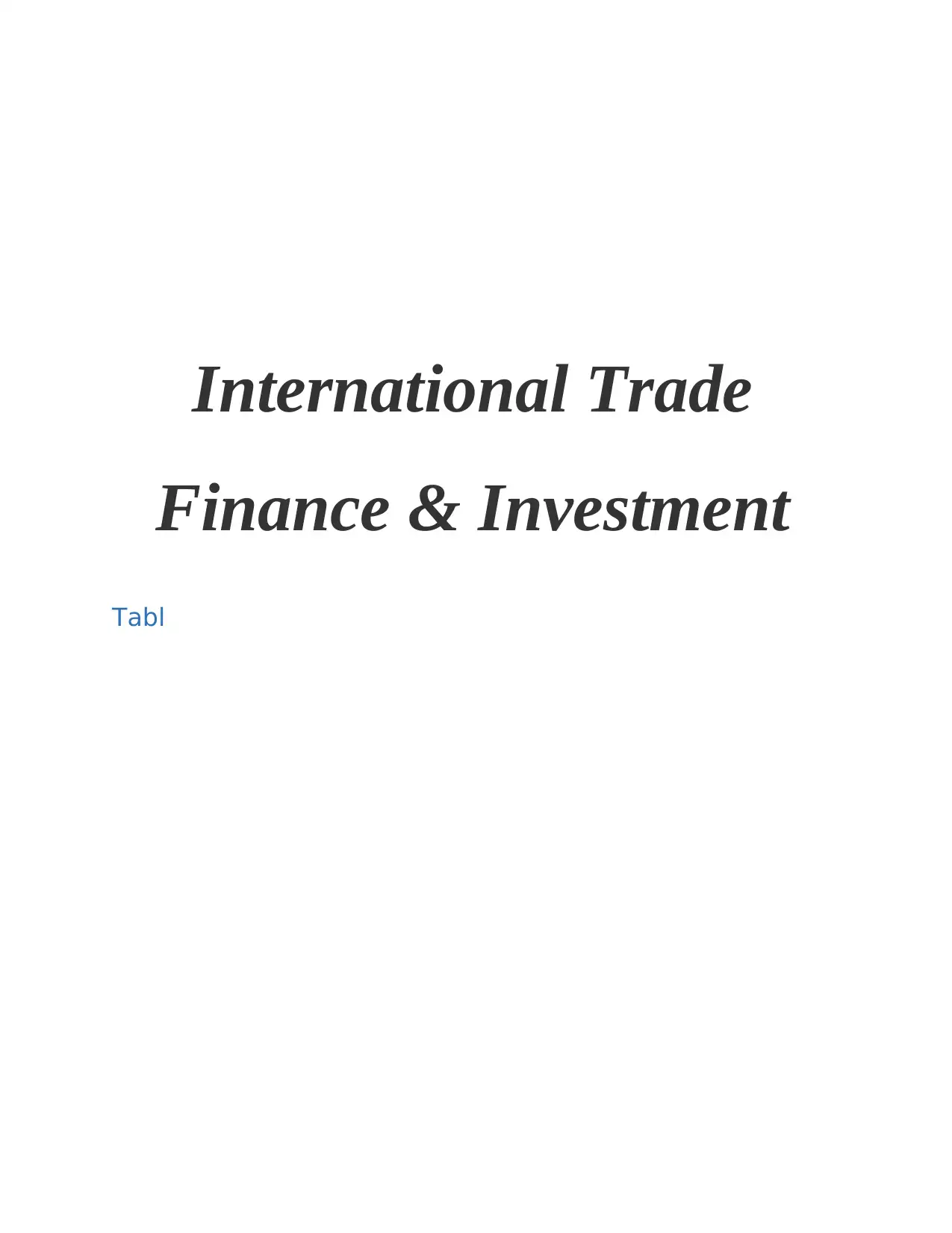
International Trade
Finance & Investment
Tabl
Finance & Investment
Tabl
Secure Best Marks with AI Grader
Need help grading? Try our AI Grader for instant feedback on your assignments.
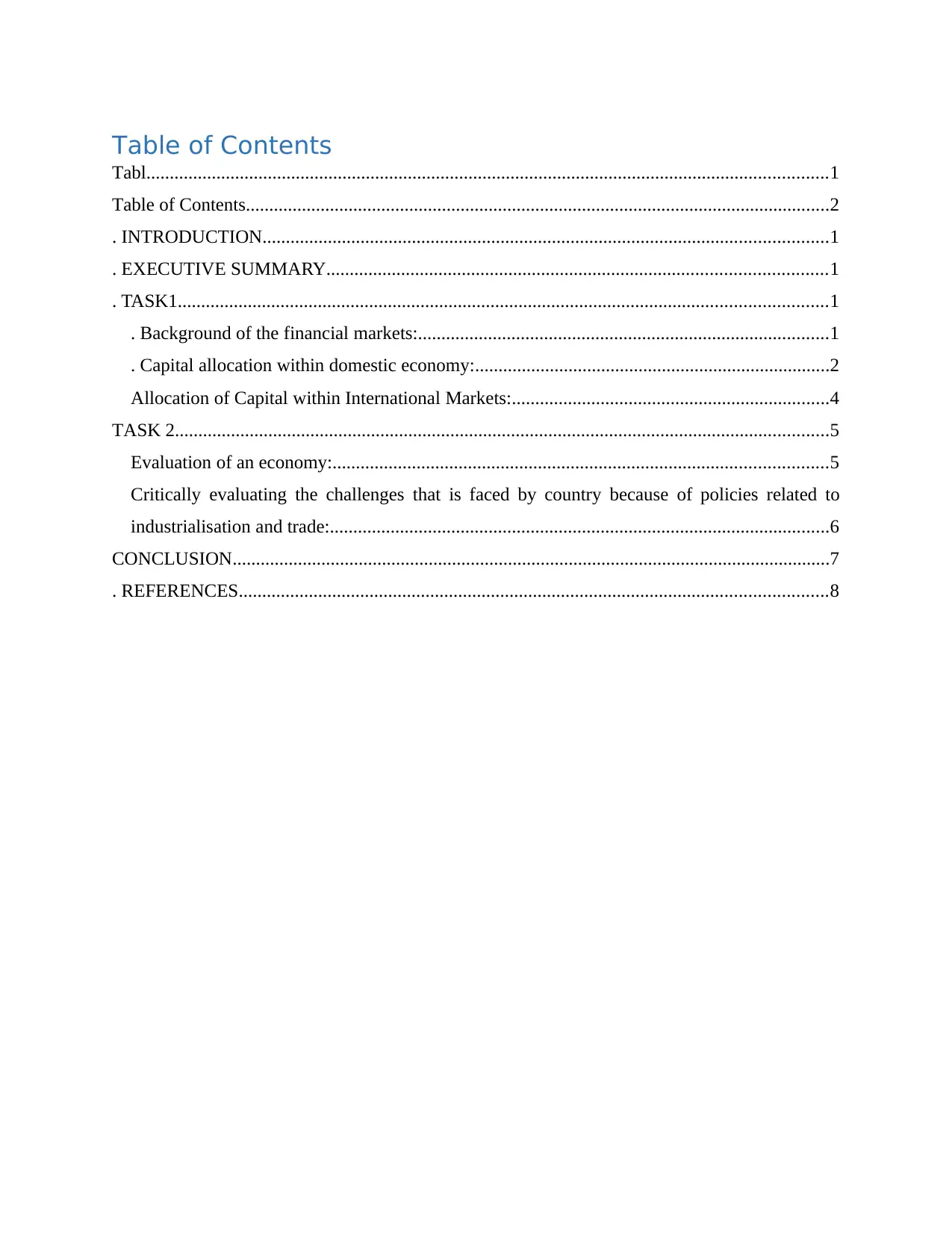
Table of Contents
Tabl..................................................................................................................................................1
Table of Contents.............................................................................................................................2
. INTRODUCTION.........................................................................................................................1
. EXECUTIVE SUMMARY...........................................................................................................1
. TASK1...........................................................................................................................................1
. Background of the financial markets:........................................................................................1
. Capital allocation within domestic economy:............................................................................2
Allocation of Capital within International Markets:....................................................................4
TASK 2............................................................................................................................................5
Evaluation of an economy:..........................................................................................................5
Critically evaluating the challenges that is faced by country because of policies related to
industrialisation and trade:...........................................................................................................6
CONCLUSION................................................................................................................................7
. REFERENCES..............................................................................................................................8
Tabl..................................................................................................................................................1
Table of Contents.............................................................................................................................2
. INTRODUCTION.........................................................................................................................1
. EXECUTIVE SUMMARY...........................................................................................................1
. TASK1...........................................................................................................................................1
. Background of the financial markets:........................................................................................1
. Capital allocation within domestic economy:............................................................................2
Allocation of Capital within International Markets:....................................................................4
TASK 2............................................................................................................................................5
Evaluation of an economy:..........................................................................................................5
Critically evaluating the challenges that is faced by country because of policies related to
industrialisation and trade:...........................................................................................................6
CONCLUSION................................................................................................................................7
. REFERENCES..............................................................................................................................8
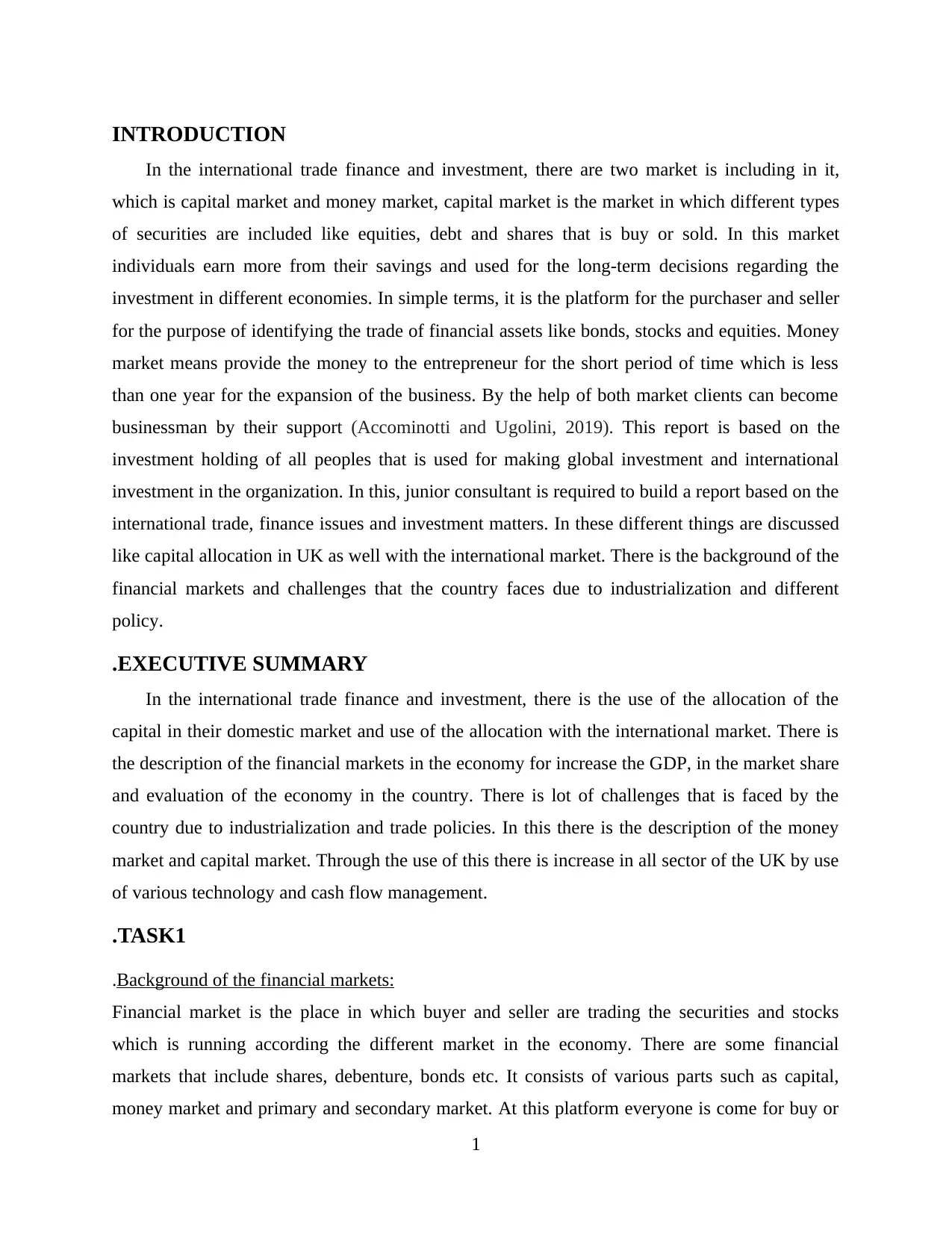
INTRODUCTION
In the international trade finance and investment, there are two market is including in it,
which is capital market and money market, capital market is the market in which different types
of securities are included like equities, debt and shares that is buy or sold. In this market
individuals earn more from their savings and used for the long-term decisions regarding the
investment in different economies. In simple terms, it is the platform for the purchaser and seller
for the purpose of identifying the trade of financial assets like bonds, stocks and equities. Money
market means provide the money to the entrepreneur for the short period of time which is less
than one year for the expansion of the business. By the help of both market clients can become
businessman by their support (Accominotti and Ugolini, 2019). This report is based on the
investment holding of all peoples that is used for making global investment and international
investment in the organization. In this, junior consultant is required to build a report based on the
international trade, finance issues and investment matters. In these different things are discussed
like capital allocation in UK as well with the international market. There is the background of the
financial markets and challenges that the country faces due to industrialization and different
policy.
.EXECUTIVE SUMMARY
In the international trade finance and investment, there is the use of the allocation of the
capital in their domestic market and use of the allocation with the international market. There is
the description of the financial markets in the economy for increase the GDP, in the market share
and evaluation of the economy in the country. There is lot of challenges that is faced by the
country due to industrialization and trade policies. In this there is the description of the money
market and capital market. Through the use of this there is increase in all sector of the UK by use
of various technology and cash flow management.
.TASK1
.Background of the financial markets:
Financial market is the place in which buyer and seller are trading the securities and stocks
which is running according the different market in the economy. There are some financial
markets that include shares, debenture, bonds etc. It consists of various parts such as capital,
money market and primary and secondary market. At this platform everyone is come for buy or
1
In the international trade finance and investment, there are two market is including in it,
which is capital market and money market, capital market is the market in which different types
of securities are included like equities, debt and shares that is buy or sold. In this market
individuals earn more from their savings and used for the long-term decisions regarding the
investment in different economies. In simple terms, it is the platform for the purchaser and seller
for the purpose of identifying the trade of financial assets like bonds, stocks and equities. Money
market means provide the money to the entrepreneur for the short period of time which is less
than one year for the expansion of the business. By the help of both market clients can become
businessman by their support (Accominotti and Ugolini, 2019). This report is based on the
investment holding of all peoples that is used for making global investment and international
investment in the organization. In this, junior consultant is required to build a report based on the
international trade, finance issues and investment matters. In these different things are discussed
like capital allocation in UK as well with the international market. There is the background of the
financial markets and challenges that the country faces due to industrialization and different
policy.
.EXECUTIVE SUMMARY
In the international trade finance and investment, there is the use of the allocation of the
capital in their domestic market and use of the allocation with the international market. There is
the description of the financial markets in the economy for increase the GDP, in the market share
and evaluation of the economy in the country. There is lot of challenges that is faced by the
country due to industrialization and trade policies. In this there is the description of the money
market and capital market. Through the use of this there is increase in all sector of the UK by use
of various technology and cash flow management.
.TASK1
.Background of the financial markets:
Financial market is the place in which buyer and seller are trading the securities and stocks
which is running according the different market in the economy. There are some financial
markets that include shares, debenture, bonds etc. It consists of various parts such as capital,
money market and primary and secondary market. At this platform everyone is come for buy or
1
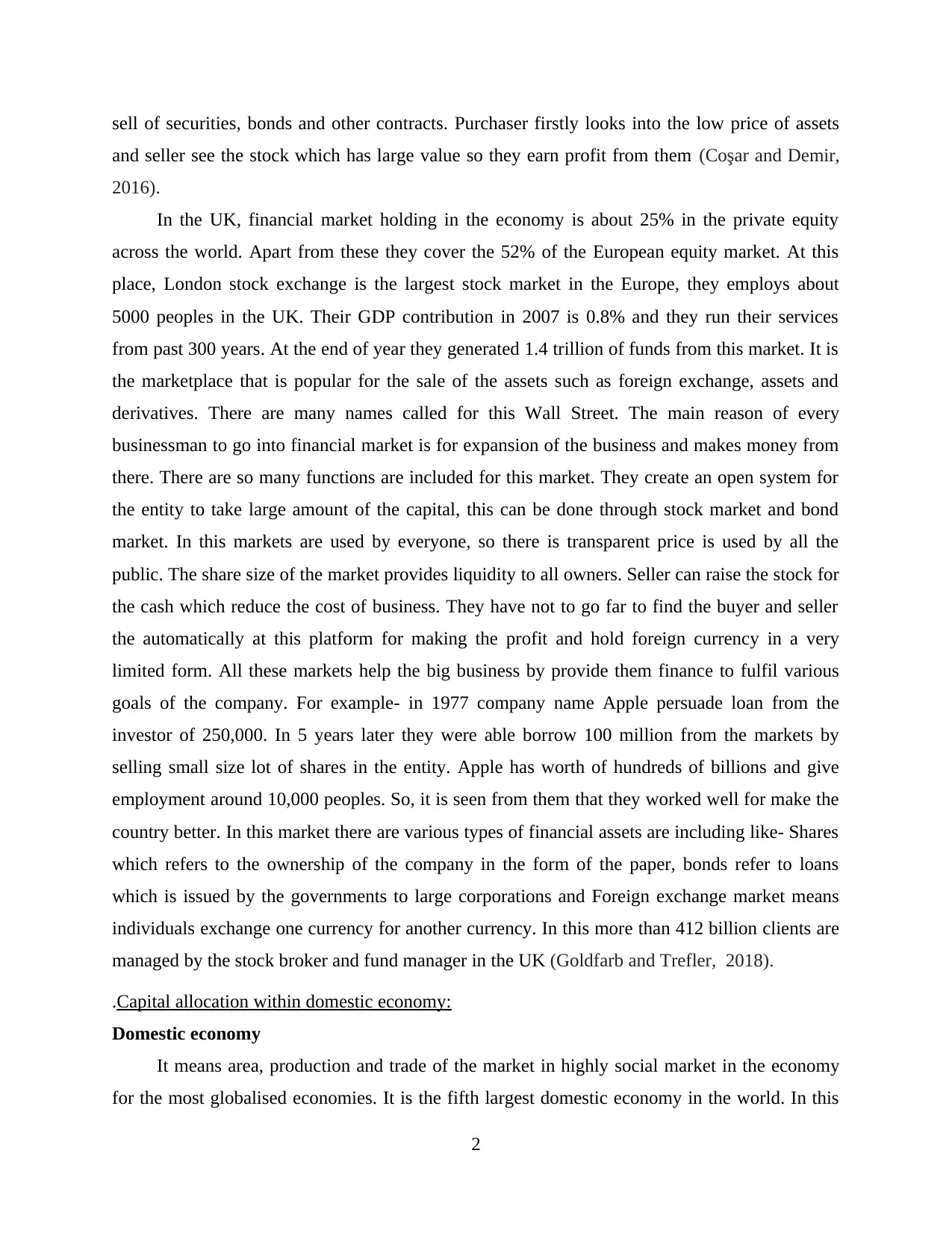
sell of securities, bonds and other contracts. Purchaser firstly looks into the low price of assets
and seller see the stock which has large value so they earn profit from them (Coşar and Demir,
2016).
In the UK, financial market holding in the economy is about 25% in the private equity
across the world. Apart from these they cover the 52% of the European equity market. At this
place, London stock exchange is the largest stock market in the Europe, they employs about
5000 peoples in the UK. Their GDP contribution in 2007 is 0.8% and they run their services
from past 300 years. At the end of year they generated 1.4 trillion of funds from this market. It is
the marketplace that is popular for the sale of the assets such as foreign exchange, assets and
derivatives. There are many names called for this Wall Street. The main reason of every
businessman to go into financial market is for expansion of the business and makes money from
there. There are so many functions are included for this market. They create an open system for
the entity to take large amount of the capital, this can be done through stock market and bond
market. In this markets are used by everyone, so there is transparent price is used by all the
public. The share size of the market provides liquidity to all owners. Seller can raise the stock for
the cash which reduce the cost of business. They have not to go far to find the buyer and seller
the automatically at this platform for making the profit and hold foreign currency in a very
limited form. All these markets help the big business by provide them finance to fulfil various
goals of the company. For example- in 1977 company name Apple persuade loan from the
investor of 250,000. In 5 years later they were able borrow 100 million from the markets by
selling small size lot of shares in the entity. Apple has worth of hundreds of billions and give
employment around 10,000 peoples. So, it is seen from them that they worked well for make the
country better. In this market there are various types of financial assets are including like- Shares
which refers to the ownership of the company in the form of the paper, bonds refer to loans
which is issued by the governments to large corporations and Foreign exchange market means
individuals exchange one currency for another currency. In this more than 412 billion clients are
managed by the stock broker and fund manager in the UK (Goldfarb and Trefler, 2018).
.Capital allocation within domestic economy:
Domestic economy
It means area, production and trade of the market in highly social market in the economy
for the most globalised economies. It is the fifth largest domestic economy in the world. In this
2
and seller see the stock which has large value so they earn profit from them (Coşar and Demir,
2016).
In the UK, financial market holding in the economy is about 25% in the private equity
across the world. Apart from these they cover the 52% of the European equity market. At this
place, London stock exchange is the largest stock market in the Europe, they employs about
5000 peoples in the UK. Their GDP contribution in 2007 is 0.8% and they run their services
from past 300 years. At the end of year they generated 1.4 trillion of funds from this market. It is
the marketplace that is popular for the sale of the assets such as foreign exchange, assets and
derivatives. There are many names called for this Wall Street. The main reason of every
businessman to go into financial market is for expansion of the business and makes money from
there. There are so many functions are included for this market. They create an open system for
the entity to take large amount of the capital, this can be done through stock market and bond
market. In this markets are used by everyone, so there is transparent price is used by all the
public. The share size of the market provides liquidity to all owners. Seller can raise the stock for
the cash which reduce the cost of business. They have not to go far to find the buyer and seller
the automatically at this platform for making the profit and hold foreign currency in a very
limited form. All these markets help the big business by provide them finance to fulfil various
goals of the company. For example- in 1977 company name Apple persuade loan from the
investor of 250,000. In 5 years later they were able borrow 100 million from the markets by
selling small size lot of shares in the entity. Apple has worth of hundreds of billions and give
employment around 10,000 peoples. So, it is seen from them that they worked well for make the
country better. In this market there are various types of financial assets are including like- Shares
which refers to the ownership of the company in the form of the paper, bonds refer to loans
which is issued by the governments to large corporations and Foreign exchange market means
individuals exchange one currency for another currency. In this more than 412 billion clients are
managed by the stock broker and fund manager in the UK (Goldfarb and Trefler, 2018).
.Capital allocation within domestic economy:
Domestic economy
It means area, production and trade of the market in highly social market in the economy
for the most globalised economies. It is the fifth largest domestic economy in the world. In this
2
Secure Best Marks with AI Grader
Need help grading? Try our AI Grader for instant feedback on your assignments.
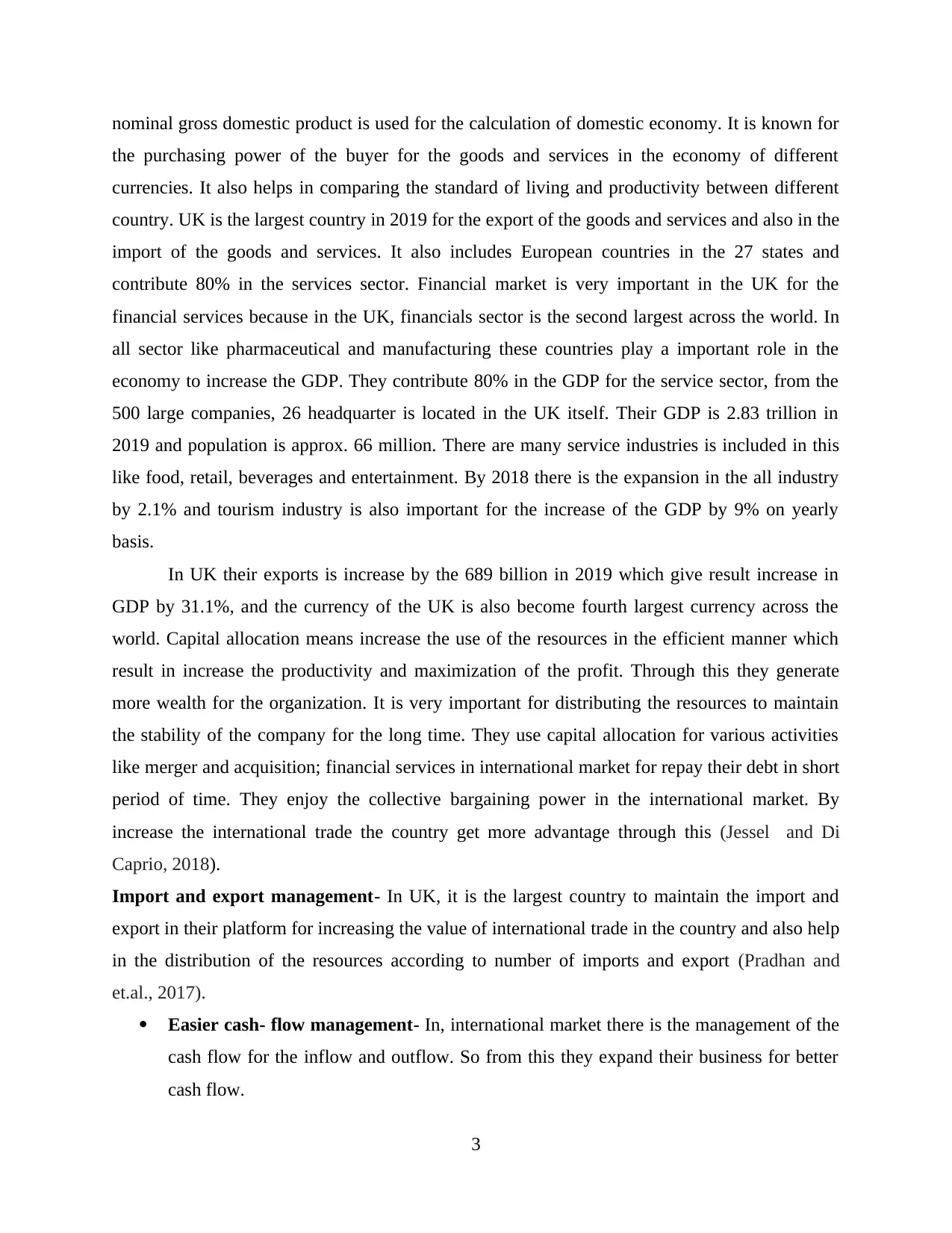
nominal gross domestic product is used for the calculation of domestic economy. It is known for
the purchasing power of the buyer for the goods and services in the economy of different
currencies. It also helps in comparing the standard of living and productivity between different
country. UK is the largest country in 2019 for the export of the goods and services and also in the
import of the goods and services. It also includes European countries in the 27 states and
contribute 80% in the services sector. Financial market is very important in the UK for the
financial services because in the UK, financials sector is the second largest across the world. In
all sector like pharmaceutical and manufacturing these countries play a important role in the
economy to increase the GDP. They contribute 80% in the GDP for the service sector, from the
500 large companies, 26 headquarter is located in the UK itself. Their GDP is 2.83 trillion in
2019 and population is approx. 66 million. There are many service industries is included in this
like food, retail, beverages and entertainment. By 2018 there is the expansion in the all industry
by 2.1% and tourism industry is also important for the increase of the GDP by 9% on yearly
basis.
In UK their exports is increase by the 689 billion in 2019 which give result increase in
GDP by 31.1%, and the currency of the UK is also become fourth largest currency across the
world. Capital allocation means increase the use of the resources in the efficient manner which
result in increase the productivity and maximization of the profit. Through this they generate
more wealth for the organization. It is very important for distributing the resources to maintain
the stability of the company for the long time. They use capital allocation for various activities
like merger and acquisition; financial services in international market for repay their debt in short
period of time. They enjoy the collective bargaining power in the international market. By
increase the international trade the country get more advantage through this (Jessel and Di
Caprio, 2018).
Import and export management- In UK, it is the largest country to maintain the import and
export in their platform for increasing the value of international trade in the country and also help
in the distribution of the resources according to number of imports and export (Pradhan and
et.al., 2017).
Easier cash- flow management- In, international market there is the management of the
cash flow for the inflow and outflow. So from this they expand their business for better
cash flow.
3
the purchasing power of the buyer for the goods and services in the economy of different
currencies. It also helps in comparing the standard of living and productivity between different
country. UK is the largest country in 2019 for the export of the goods and services and also in the
import of the goods and services. It also includes European countries in the 27 states and
contribute 80% in the services sector. Financial market is very important in the UK for the
financial services because in the UK, financials sector is the second largest across the world. In
all sector like pharmaceutical and manufacturing these countries play a important role in the
economy to increase the GDP. They contribute 80% in the GDP for the service sector, from the
500 large companies, 26 headquarter is located in the UK itself. Their GDP is 2.83 trillion in
2019 and population is approx. 66 million. There are many service industries is included in this
like food, retail, beverages and entertainment. By 2018 there is the expansion in the all industry
by 2.1% and tourism industry is also important for the increase of the GDP by 9% on yearly
basis.
In UK their exports is increase by the 689 billion in 2019 which give result increase in
GDP by 31.1%, and the currency of the UK is also become fourth largest currency across the
world. Capital allocation means increase the use of the resources in the efficient manner which
result in increase the productivity and maximization of the profit. Through this they generate
more wealth for the organization. It is very important for distributing the resources to maintain
the stability of the company for the long time. They use capital allocation for various activities
like merger and acquisition; financial services in international market for repay their debt in short
period of time. They enjoy the collective bargaining power in the international market. By
increase the international trade the country get more advantage through this (Jessel and Di
Caprio, 2018).
Import and export management- In UK, it is the largest country to maintain the import and
export in their platform for increasing the value of international trade in the country and also help
in the distribution of the resources according to number of imports and export (Pradhan and
et.al., 2017).
Easier cash- flow management- In, international market there is the management of the
cash flow for the inflow and outflow. So from this they expand their business for better
cash flow.
3
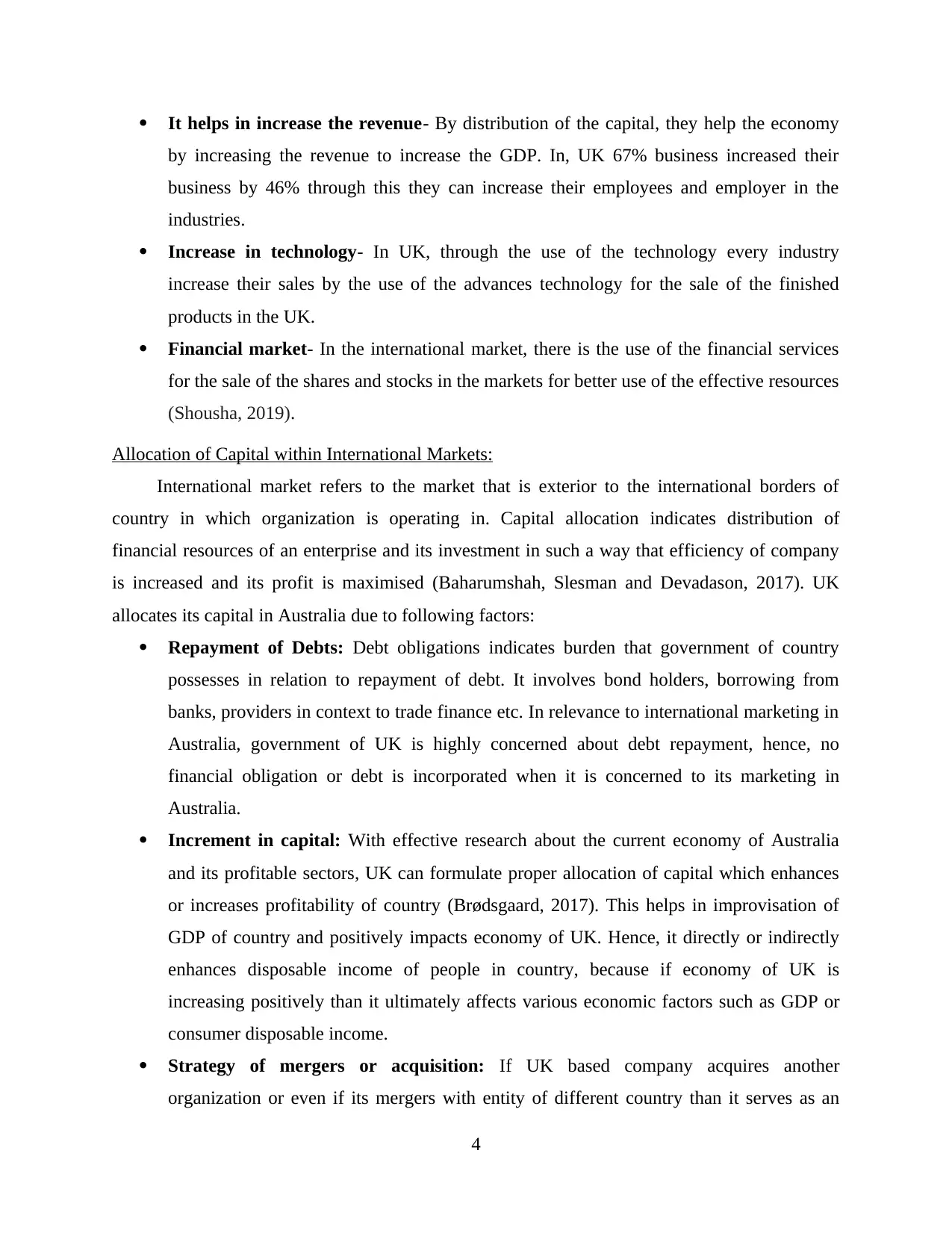
It helps in increase the revenue- By distribution of the capital, they help the economy
by increasing the revenue to increase the GDP. In, UK 67% business increased their
business by 46% through this they can increase their employees and employer in the
industries.
Increase in technology- In UK, through the use of the technology every industry
increase their sales by the use of the advances technology for the sale of the finished
products in the UK.
Financial market- In the international market, there is the use of the financial services
for the sale of the shares and stocks in the markets for better use of the effective resources
(Shousha, 2019).
Allocation of Capital within International Markets:
International market refers to the market that is exterior to the international borders of
country in which organization is operating in. Capital allocation indicates distribution of
financial resources of an enterprise and its investment in such a way that efficiency of company
is increased and its profit is maximised (Baharumshah, Slesman and Devadason, 2017). UK
allocates its capital in Australia due to following factors:
Repayment of Debts: Debt obligations indicates burden that government of country
possesses in relation to repayment of debt. It involves bond holders, borrowing from
banks, providers in context to trade finance etc. In relevance to international marketing in
Australia, government of UK is highly concerned about debt repayment, hence, no
financial obligation or debt is incorporated when it is concerned to its marketing in
Australia.
Increment in capital: With effective research about the current economy of Australia
and its profitable sectors, UK can formulate proper allocation of capital which enhances
or increases profitability of country (Brødsgaard, 2017). This helps in improvisation of
GDP of country and positively impacts economy of UK. Hence, it directly or indirectly
enhances disposable income of people in country, because if economy of UK is
increasing positively than it ultimately affects various economic factors such as GDP or
consumer disposable income.
Strategy of mergers or acquisition: If UK based company acquires another
organization or even if its mergers with entity of different country than it serves as an
4
by increasing the revenue to increase the GDP. In, UK 67% business increased their
business by 46% through this they can increase their employees and employer in the
industries.
Increase in technology- In UK, through the use of the technology every industry
increase their sales by the use of the advances technology for the sale of the finished
products in the UK.
Financial market- In the international market, there is the use of the financial services
for the sale of the shares and stocks in the markets for better use of the effective resources
(Shousha, 2019).
Allocation of Capital within International Markets:
International market refers to the market that is exterior to the international borders of
country in which organization is operating in. Capital allocation indicates distribution of
financial resources of an enterprise and its investment in such a way that efficiency of company
is increased and its profit is maximised (Baharumshah, Slesman and Devadason, 2017). UK
allocates its capital in Australia due to following factors:
Repayment of Debts: Debt obligations indicates burden that government of country
possesses in relation to repayment of debt. It involves bond holders, borrowing from
banks, providers in context to trade finance etc. In relevance to international marketing in
Australia, government of UK is highly concerned about debt repayment, hence, no
financial obligation or debt is incorporated when it is concerned to its marketing in
Australia.
Increment in capital: With effective research about the current economy of Australia
and its profitable sectors, UK can formulate proper allocation of capital which enhances
or increases profitability of country (Brødsgaard, 2017). This helps in improvisation of
GDP of country and positively impacts economy of UK. Hence, it directly or indirectly
enhances disposable income of people in country, because if economy of UK is
increasing positively than it ultimately affects various economic factors such as GDP or
consumer disposable income.
Strategy of mergers or acquisition: If UK based company acquires another
organization or even if its mergers with entity of different country than it serves as an
4
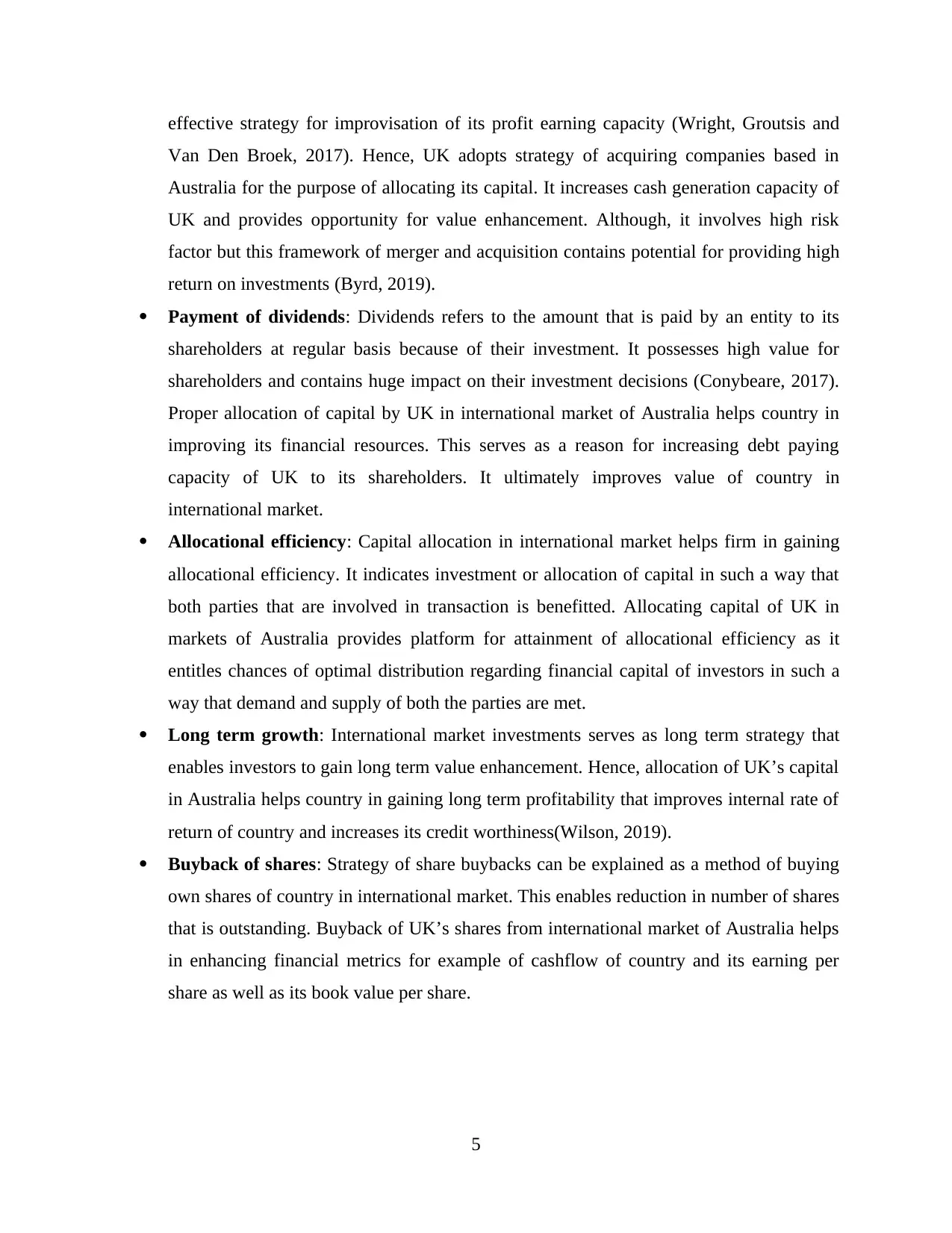
effective strategy for improvisation of its profit earning capacity (Wright, Groutsis and
Van Den Broek, 2017). Hence, UK adopts strategy of acquiring companies based in
Australia for the purpose of allocating its capital. It increases cash generation capacity of
UK and provides opportunity for value enhancement. Although, it involves high risk
factor but this framework of merger and acquisition contains potential for providing high
return on investments (Byrd, 2019).
Payment of dividends: Dividends refers to the amount that is paid by an entity to its
shareholders at regular basis because of their investment. It possesses high value for
shareholders and contains huge impact on their investment decisions (Conybeare, 2017).
Proper allocation of capital by UK in international market of Australia helps country in
improving its financial resources. This serves as a reason for increasing debt paying
capacity of UK to its shareholders. It ultimately improves value of country in
international market.
Allocational efficiency: Capital allocation in international market helps firm in gaining
allocational efficiency. It indicates investment or allocation of capital in such a way that
both parties that are involved in transaction is benefitted. Allocating capital of UK in
markets of Australia provides platform for attainment of allocational efficiency as it
entitles chances of optimal distribution regarding financial capital of investors in such a
way that demand and supply of both the parties are met.
Long term growth: International market investments serves as long term strategy that
enables investors to gain long term value enhancement. Hence, allocation of UK’s capital
in Australia helps country in gaining long term profitability that improves internal rate of
return of country and increases its credit worthiness(Wilson, 2019).
Buyback of shares: Strategy of share buybacks can be explained as a method of buying
own shares of country in international market. This enables reduction in number of shares
that is outstanding. Buyback of UK’s shares from international market of Australia helps
in enhancing financial metrics for example of cashflow of country and its earning per
share as well as its book value per share.
5
Van Den Broek, 2017). Hence, UK adopts strategy of acquiring companies based in
Australia for the purpose of allocating its capital. It increases cash generation capacity of
UK and provides opportunity for value enhancement. Although, it involves high risk
factor but this framework of merger and acquisition contains potential for providing high
return on investments (Byrd, 2019).
Payment of dividends: Dividends refers to the amount that is paid by an entity to its
shareholders at regular basis because of their investment. It possesses high value for
shareholders and contains huge impact on their investment decisions (Conybeare, 2017).
Proper allocation of capital by UK in international market of Australia helps country in
improving its financial resources. This serves as a reason for increasing debt paying
capacity of UK to its shareholders. It ultimately improves value of country in
international market.
Allocational efficiency: Capital allocation in international market helps firm in gaining
allocational efficiency. It indicates investment or allocation of capital in such a way that
both parties that are involved in transaction is benefitted. Allocating capital of UK in
markets of Australia provides platform for attainment of allocational efficiency as it
entitles chances of optimal distribution regarding financial capital of investors in such a
way that demand and supply of both the parties are met.
Long term growth: International market investments serves as long term strategy that
enables investors to gain long term value enhancement. Hence, allocation of UK’s capital
in Australia helps country in gaining long term profitability that improves internal rate of
return of country and increases its credit worthiness(Wilson, 2019).
Buyback of shares: Strategy of share buybacks can be explained as a method of buying
own shares of country in international market. This enables reduction in number of shares
that is outstanding. Buyback of UK’s shares from international market of Australia helps
in enhancing financial metrics for example of cashflow of country and its earning per
share as well as its book value per share.
5
Paraphrase This Document
Need a fresh take? Get an instant paraphrase of this document with our AI Paraphraser
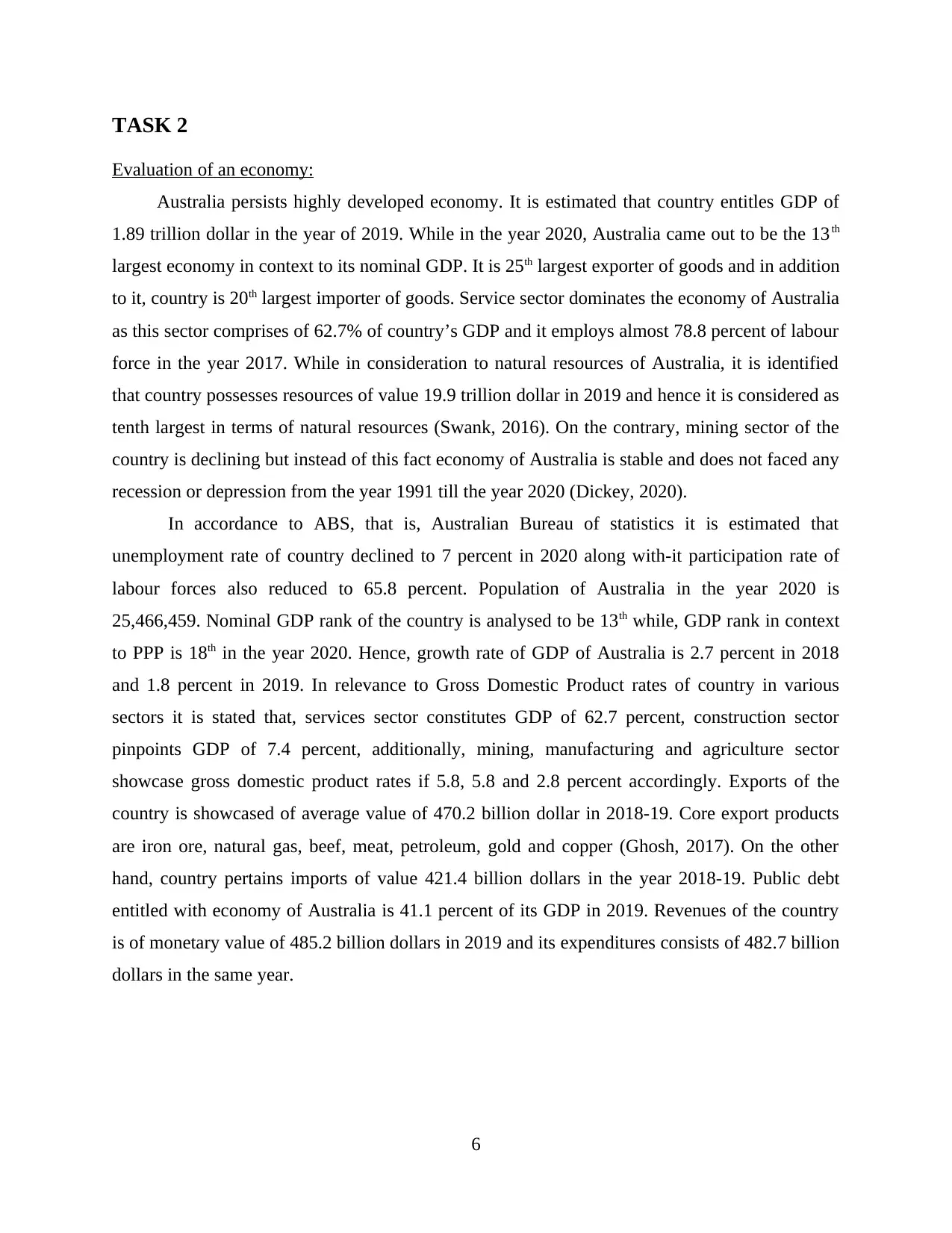
TASK 2
Evaluation of an economy:
Australia persists highly developed economy. It is estimated that country entitles GDP of
1.89 trillion dollar in the year of 2019. While in the year 2020, Australia came out to be the 13 th
largest economy in context to its nominal GDP. It is 25th largest exporter of goods and in addition
to it, country is 20th largest importer of goods. Service sector dominates the economy of Australia
as this sector comprises of 62.7% of country’s GDP and it employs almost 78.8 percent of labour
force in the year 2017. While in consideration to natural resources of Australia, it is identified
that country possesses resources of value 19.9 trillion dollar in 2019 and hence it is considered as
tenth largest in terms of natural resources (Swank, 2016). On the contrary, mining sector of the
country is declining but instead of this fact economy of Australia is stable and does not faced any
recession or depression from the year 1991 till the year 2020 (Dickey, 2020).
In accordance to ABS, that is, Australian Bureau of statistics it is estimated that
unemployment rate of country declined to 7 percent in 2020 along with-it participation rate of
labour forces also reduced to 65.8 percent. Population of Australia in the year 2020 is
25,466,459. Nominal GDP rank of the country is analysed to be 13th while, GDP rank in context
to PPP is 18th in the year 2020. Hence, growth rate of GDP of Australia is 2.7 percent in 2018
and 1.8 percent in 2019. In relevance to Gross Domestic Product rates of country in various
sectors it is stated that, services sector constitutes GDP of 62.7 percent, construction sector
pinpoints GDP of 7.4 percent, additionally, mining, manufacturing and agriculture sector
showcase gross domestic product rates if 5.8, 5.8 and 2.8 percent accordingly. Exports of the
country is showcased of average value of 470.2 billion dollar in 2018-19. Core export products
are iron ore, natural gas, beef, meat, petroleum, gold and copper (Ghosh, 2017). On the other
hand, country pertains imports of value 421.4 billion dollars in the year 2018-19. Public debt
entitled with economy of Australia is 41.1 percent of its GDP in 2019. Revenues of the country
is of monetary value of 485.2 billion dollars in 2019 and its expenditures consists of 482.7 billion
dollars in the same year.
6
Evaluation of an economy:
Australia persists highly developed economy. It is estimated that country entitles GDP of
1.89 trillion dollar in the year of 2019. While in the year 2020, Australia came out to be the 13 th
largest economy in context to its nominal GDP. It is 25th largest exporter of goods and in addition
to it, country is 20th largest importer of goods. Service sector dominates the economy of Australia
as this sector comprises of 62.7% of country’s GDP and it employs almost 78.8 percent of labour
force in the year 2017. While in consideration to natural resources of Australia, it is identified
that country possesses resources of value 19.9 trillion dollar in 2019 and hence it is considered as
tenth largest in terms of natural resources (Swank, 2016). On the contrary, mining sector of the
country is declining but instead of this fact economy of Australia is stable and does not faced any
recession or depression from the year 1991 till the year 2020 (Dickey, 2020).
In accordance to ABS, that is, Australian Bureau of statistics it is estimated that
unemployment rate of country declined to 7 percent in 2020 along with-it participation rate of
labour forces also reduced to 65.8 percent. Population of Australia in the year 2020 is
25,466,459. Nominal GDP rank of the country is analysed to be 13th while, GDP rank in context
to PPP is 18th in the year 2020. Hence, growth rate of GDP of Australia is 2.7 percent in 2018
and 1.8 percent in 2019. In relevance to Gross Domestic Product rates of country in various
sectors it is stated that, services sector constitutes GDP of 62.7 percent, construction sector
pinpoints GDP of 7.4 percent, additionally, mining, manufacturing and agriculture sector
showcase gross domestic product rates if 5.8, 5.8 and 2.8 percent accordingly. Exports of the
country is showcased of average value of 470.2 billion dollar in 2018-19. Core export products
are iron ore, natural gas, beef, meat, petroleum, gold and copper (Ghosh, 2017). On the other
hand, country pertains imports of value 421.4 billion dollars in the year 2018-19. Public debt
entitled with economy of Australia is 41.1 percent of its GDP in 2019. Revenues of the country
is of monetary value of 485.2 billion dollars in 2019 and its expenditures consists of 482.7 billion
dollars in the same year.
6
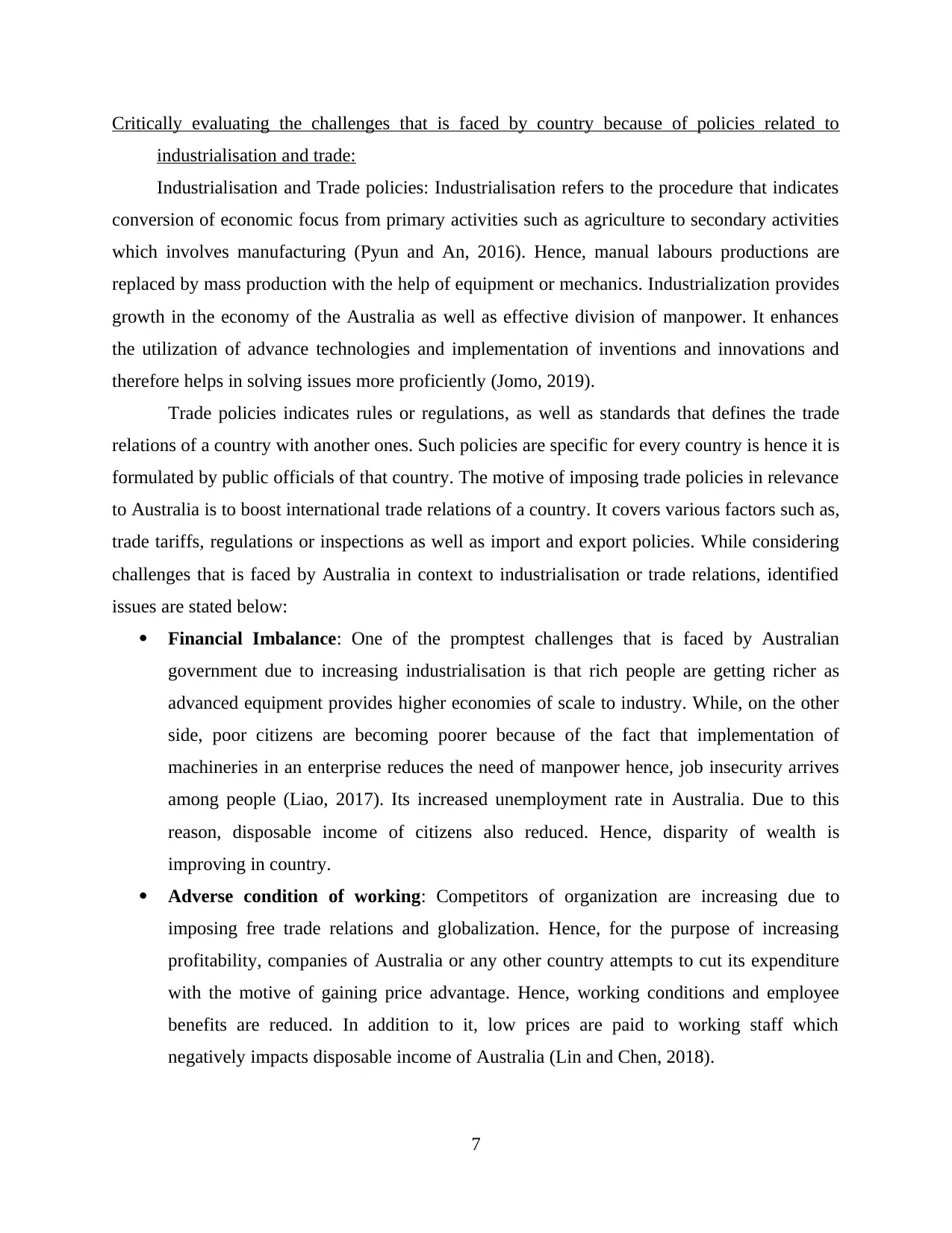
Critically evaluating the challenges that is faced by country because of policies related to
industrialisation and trade:
Industrialisation and Trade policies: Industrialisation refers to the procedure that indicates
conversion of economic focus from primary activities such as agriculture to secondary activities
which involves manufacturing (Pyun and An, 2016). Hence, manual labours productions are
replaced by mass production with the help of equipment or mechanics. Industrialization provides
growth in the economy of the Australia as well as effective division of manpower. It enhances
the utilization of advance technologies and implementation of inventions and innovations and
therefore helps in solving issues more proficiently (Jomo, 2019).
Trade policies indicates rules or regulations, as well as standards that defines the trade
relations of a country with another ones. Such policies are specific for every country is hence it is
formulated by public officials of that country. The motive of imposing trade policies in relevance
to Australia is to boost international trade relations of a country. It covers various factors such as,
trade tariffs, regulations or inspections as well as import and export policies. While considering
challenges that is faced by Australia in context to industrialisation or trade relations, identified
issues are stated below:
Financial Imbalance: One of the promptest challenges that is faced by Australian
government due to increasing industrialisation is that rich people are getting richer as
advanced equipment provides higher economies of scale to industry. While, on the other
side, poor citizens are becoming poorer because of the fact that implementation of
machineries in an enterprise reduces the need of manpower hence, job insecurity arrives
among people (Liao, 2017). Its increased unemployment rate in Australia. Due to this
reason, disposable income of citizens also reduced. Hence, disparity of wealth is
improving in country.
Adverse condition of working: Competitors of organization are increasing due to
imposing free trade relations and globalization. Hence, for the purpose of increasing
profitability, companies of Australia or any other country attempts to cut its expenditure
with the motive of gaining price advantage. Hence, working conditions and employee
benefits are reduced. In addition to it, low prices are paid to working staff which
negatively impacts disposable income of Australia (Lin and Chen, 2018).
7
industrialisation and trade:
Industrialisation and Trade policies: Industrialisation refers to the procedure that indicates
conversion of economic focus from primary activities such as agriculture to secondary activities
which involves manufacturing (Pyun and An, 2016). Hence, manual labours productions are
replaced by mass production with the help of equipment or mechanics. Industrialization provides
growth in the economy of the Australia as well as effective division of manpower. It enhances
the utilization of advance technologies and implementation of inventions and innovations and
therefore helps in solving issues more proficiently (Jomo, 2019).
Trade policies indicates rules or regulations, as well as standards that defines the trade
relations of a country with another ones. Such policies are specific for every country is hence it is
formulated by public officials of that country. The motive of imposing trade policies in relevance
to Australia is to boost international trade relations of a country. It covers various factors such as,
trade tariffs, regulations or inspections as well as import and export policies. While considering
challenges that is faced by Australia in context to industrialisation or trade relations, identified
issues are stated below:
Financial Imbalance: One of the promptest challenges that is faced by Australian
government due to increasing industrialisation is that rich people are getting richer as
advanced equipment provides higher economies of scale to industry. While, on the other
side, poor citizens are becoming poorer because of the fact that implementation of
machineries in an enterprise reduces the need of manpower hence, job insecurity arrives
among people (Liao, 2017). Its increased unemployment rate in Australia. Due to this
reason, disposable income of citizens also reduced. Hence, disparity of wealth is
improving in country.
Adverse condition of working: Competitors of organization are increasing due to
imposing free trade relations and globalization. Hence, for the purpose of increasing
profitability, companies of Australia or any other country attempts to cut its expenditure
with the motive of gaining price advantage. Hence, working conditions and employee
benefits are reduced. In addition to it, low prices are paid to working staff which
negatively impacts disposable income of Australia (Lin and Chen, 2018).
7
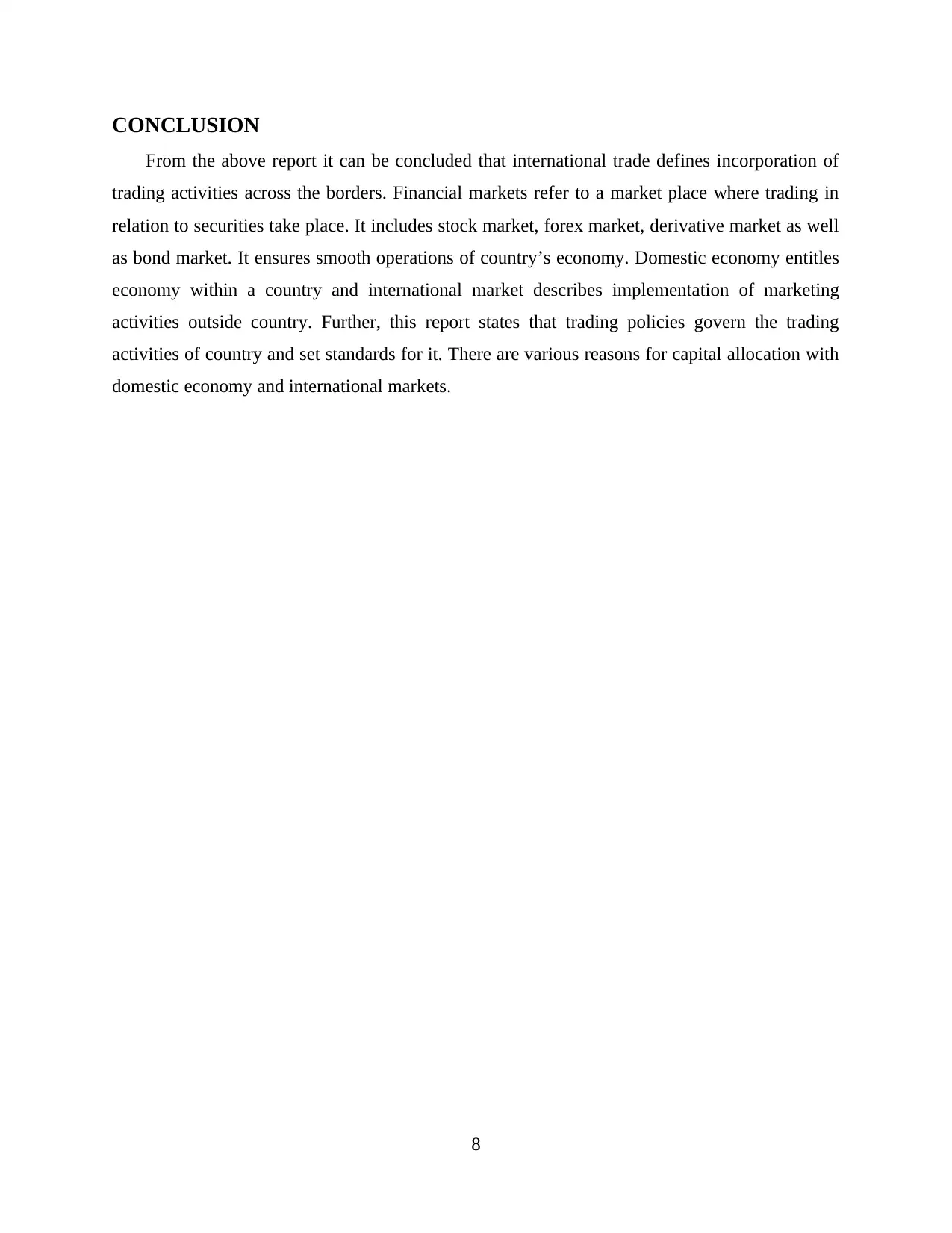
CONCLUSION
From the above report it can be concluded that international trade defines incorporation of
trading activities across the borders. Financial markets refer to a market place where trading in
relation to securities take place. It includes stock market, forex market, derivative market as well
as bond market. It ensures smooth operations of country’s economy. Domestic economy entitles
economy within a country and international market describes implementation of marketing
activities outside country. Further, this report states that trading policies govern the trading
activities of country and set standards for it. There are various reasons for capital allocation with
domestic economy and international markets.
8
From the above report it can be concluded that international trade defines incorporation of
trading activities across the borders. Financial markets refer to a market place where trading in
relation to securities take place. It includes stock market, forex market, derivative market as well
as bond market. It ensures smooth operations of country’s economy. Domestic economy entitles
economy within a country and international market describes implementation of marketing
activities outside country. Further, this report states that trading policies govern the trading
activities of country and set standards for it. There are various reasons for capital allocation with
domestic economy and international markets.
8
Secure Best Marks with AI Grader
Need help grading? Try our AI Grader for instant feedback on your assignments.
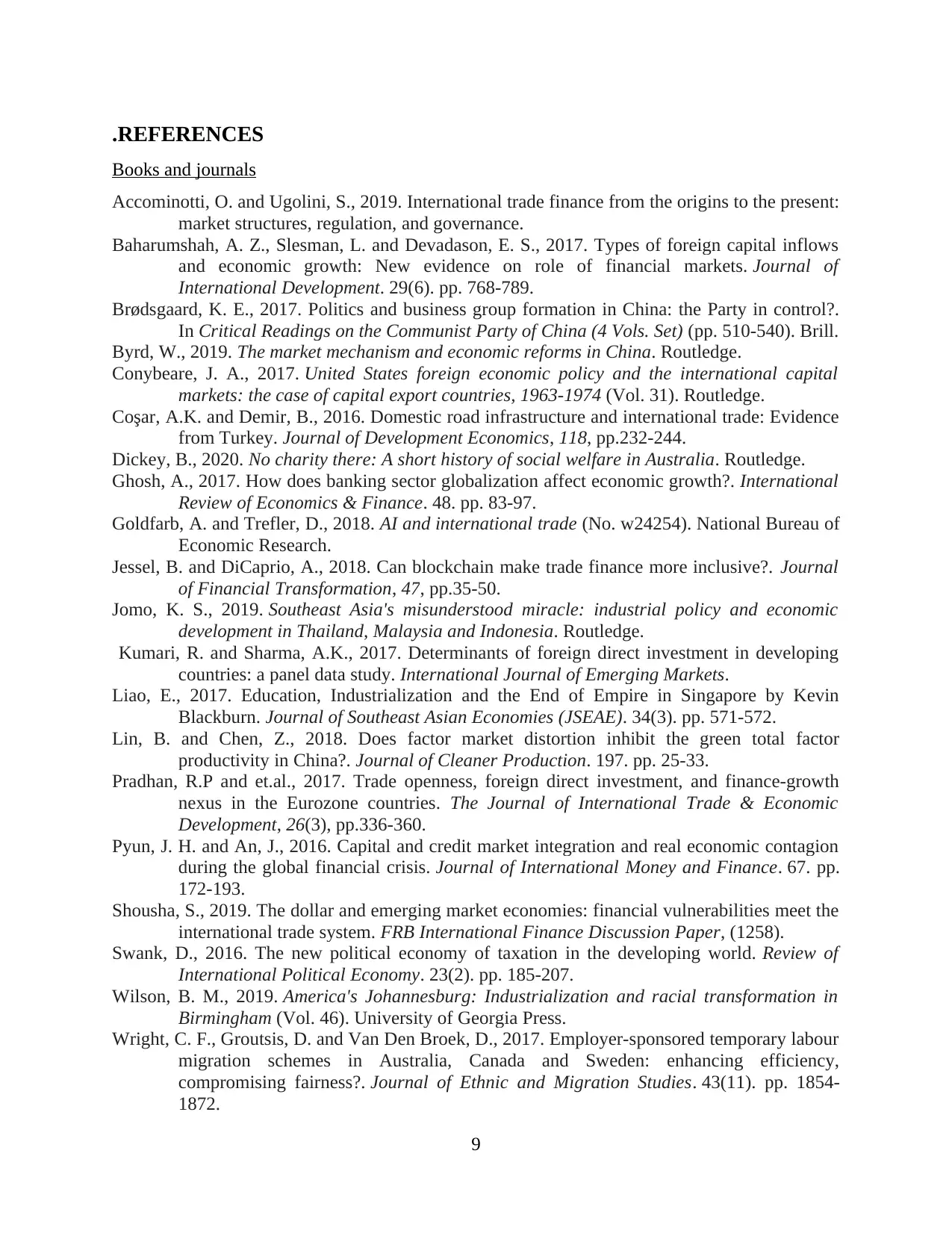
.REFERENCES
Books and journals
Accominotti, O. and Ugolini, S., 2019. International trade finance from the origins to the present:
market structures, regulation, and governance.
Baharumshah, A. Z., Slesman, L. and Devadason, E. S., 2017. Types of foreign capital inflows
and economic growth: New evidence on role of financial markets. Journal of
International Development. 29(6). pp. 768-789.
Brødsgaard, K. E., 2017. Politics and business group formation in China: the Party in control?.
In Critical Readings on the Communist Party of China (4 Vols. Set) (pp. 510-540). Brill.
Byrd, W., 2019. The market mechanism and economic reforms in China. Routledge.
Conybeare, J. A., 2017. United States foreign economic policy and the international capital
markets: the case of capital export countries, 1963-1974 (Vol. 31). Routledge.
Coşar, A.K. and Demir, B., 2016. Domestic road infrastructure and international trade: Evidence
from Turkey. Journal of Development Economics, 118, pp.232-244.
Dickey, B., 2020. No charity there: A short history of social welfare in Australia. Routledge.
Ghosh, A., 2017. How does banking sector globalization affect economic growth?. International
Review of Economics & Finance. 48. pp. 83-97.
Goldfarb, A. and Trefler, D., 2018. AI and international trade (No. w24254). National Bureau of
Economic Research.
Jessel, B. and DiCaprio, A., 2018. Can blockchain make trade finance more inclusive?. Journal
of Financial Transformation, 47, pp.35-50.
Jomo, K. S., 2019. Southeast Asia's misunderstood miracle: industrial policy and economic
development in Thailand, Malaysia and Indonesia. Routledge.
Kumari, R. and Sharma, A.K., 2017. Determinants of foreign direct investment in developing
countries: a panel data study. International Journal of Emerging Markets.
Liao, E., 2017. Education, Industrialization and the End of Empire in Singapore by Kevin
Blackburn. Journal of Southeast Asian Economies (JSEAE). 34(3). pp. 571-572.
Lin, B. and Chen, Z., 2018. Does factor market distortion inhibit the green total factor
productivity in China?. Journal of Cleaner Production. 197. pp. 25-33.
Pradhan, R.P and et.al., 2017. Trade openness, foreign direct investment, and finance-growth
nexus in the Eurozone countries. The Journal of International Trade & Economic
Development, 26(3), pp.336-360.
Pyun, J. H. and An, J., 2016. Capital and credit market integration and real economic contagion
during the global financial crisis. Journal of International Money and Finance. 67. pp.
172-193.
Shousha, S., 2019. The dollar and emerging market economies: financial vulnerabilities meet the
international trade system. FRB International Finance Discussion Paper, (1258).
Swank, D., 2016. The new political economy of taxation in the developing world. Review of
International Political Economy. 23(2). pp. 185-207.
Wilson, B. M., 2019. America's Johannesburg: Industrialization and racial transformation in
Birmingham (Vol. 46). University of Georgia Press.
Wright, C. F., Groutsis, D. and Van Den Broek, D., 2017. Employer-sponsored temporary labour
migration schemes in Australia, Canada and Sweden: enhancing efficiency,
compromising fairness?. Journal of Ethnic and Migration Studies. 43(11). pp. 1854-
1872.
9
Books and journals
Accominotti, O. and Ugolini, S., 2019. International trade finance from the origins to the present:
market structures, regulation, and governance.
Baharumshah, A. Z., Slesman, L. and Devadason, E. S., 2017. Types of foreign capital inflows
and economic growth: New evidence on role of financial markets. Journal of
International Development. 29(6). pp. 768-789.
Brødsgaard, K. E., 2017. Politics and business group formation in China: the Party in control?.
In Critical Readings on the Communist Party of China (4 Vols. Set) (pp. 510-540). Brill.
Byrd, W., 2019. The market mechanism and economic reforms in China. Routledge.
Conybeare, J. A., 2017. United States foreign economic policy and the international capital
markets: the case of capital export countries, 1963-1974 (Vol. 31). Routledge.
Coşar, A.K. and Demir, B., 2016. Domestic road infrastructure and international trade: Evidence
from Turkey. Journal of Development Economics, 118, pp.232-244.
Dickey, B., 2020. No charity there: A short history of social welfare in Australia. Routledge.
Ghosh, A., 2017. How does banking sector globalization affect economic growth?. International
Review of Economics & Finance. 48. pp. 83-97.
Goldfarb, A. and Trefler, D., 2018. AI and international trade (No. w24254). National Bureau of
Economic Research.
Jessel, B. and DiCaprio, A., 2018. Can blockchain make trade finance more inclusive?. Journal
of Financial Transformation, 47, pp.35-50.
Jomo, K. S., 2019. Southeast Asia's misunderstood miracle: industrial policy and economic
development in Thailand, Malaysia and Indonesia. Routledge.
Kumari, R. and Sharma, A.K., 2017. Determinants of foreign direct investment in developing
countries: a panel data study. International Journal of Emerging Markets.
Liao, E., 2017. Education, Industrialization and the End of Empire in Singapore by Kevin
Blackburn. Journal of Southeast Asian Economies (JSEAE). 34(3). pp. 571-572.
Lin, B. and Chen, Z., 2018. Does factor market distortion inhibit the green total factor
productivity in China?. Journal of Cleaner Production. 197. pp. 25-33.
Pradhan, R.P and et.al., 2017. Trade openness, foreign direct investment, and finance-growth
nexus in the Eurozone countries. The Journal of International Trade & Economic
Development, 26(3), pp.336-360.
Pyun, J. H. and An, J., 2016. Capital and credit market integration and real economic contagion
during the global financial crisis. Journal of International Money and Finance. 67. pp.
172-193.
Shousha, S., 2019. The dollar and emerging market economies: financial vulnerabilities meet the
international trade system. FRB International Finance Discussion Paper, (1258).
Swank, D., 2016. The new political economy of taxation in the developing world. Review of
International Political Economy. 23(2). pp. 185-207.
Wilson, B. M., 2019. America's Johannesburg: Industrialization and racial transformation in
Birmingham (Vol. 46). University of Georgia Press.
Wright, C. F., Groutsis, D. and Van Den Broek, D., 2017. Employer-sponsored temporary labour
migration schemes in Australia, Canada and Sweden: enhancing efficiency,
compromising fairness?. Journal of Ethnic and Migration Studies. 43(11). pp. 1854-
1872.
9
1 out of 11
Related Documents
Your All-in-One AI-Powered Toolkit for Academic Success.
+13062052269
info@desklib.com
Available 24*7 on WhatsApp / Email
![[object Object]](/_next/static/media/star-bottom.7253800d.svg)
Unlock your academic potential
© 2024 | Zucol Services PVT LTD | All rights reserved.





